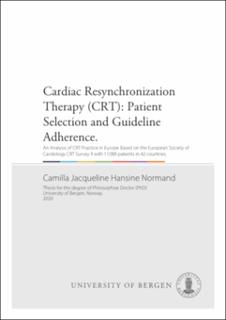Cardiac Resynchronization Therapy (CRT): Patient Selection and Guideline Adherence : An Analysis of CRT Practice in Europe Based on the European Society of Cardiology CRT Survey II with 11088 patients in 42 countries.
Doctoral thesis
Permanent lenke
https://hdl.handle.net/1956/23954Utgivelsesdato
2020-09-04Metadata
Vis full innførselSamlinger
Sammendrag
Background/Aims Cardiac Resynchronization Therapy (CRT) reduces morbidity and mortality in patients with heart failure and electrical dyssynchrony. Recommendations for which patients should receive a CRT device are outlined in cardiology society guidelines. However, these recommendations vary and for certain recommendations are imprecise. The purpose of this PhD is to explore why there are variations in international guideline recommendations and how these may contribute to differences in practice using the cohort of CRT Survey II with 11 088 patients in 42 European Society of Cardiology (ESC) member countries. Methods The recommendations provided by the major international guidelines were reviewed to identify areas of consistency and inconsistency in CRT recommendations. Data were collected on consecutive patients implanted with a CRT device in 42 ESC countries. These data were analysed to assess CRT practice and guideline adherence and relate them to variations in guideline recommendations. Results There was mainly consistency in the international guidelines regarding who should receive a device. However, some inconsistencies were identified. These included patients with non-left bundle branch block (LBBB) and patients with heart failure and a pacemaker requirement, implanted with a CRT to avoid right ventricular pacing dependence. Some of these inconsistencies could be explained by the timing of the release of the guidelines. However, others appeared to be related to CRT trial evidence being interpreted differently by different societies. In the European CRT population we found that implanters adhered well to European guidelines with only 2% of patients being implanted outside guideline recommendations. However, practice did vary in the different countries and these variations were more pronounced in areas where guideline recommendations are inconsistent or undetermined. Discussion Adherence to guidelines for CRT in Europe is high. However, in areas where there is limited CRT trial evidence this results in imprecise and inconsistent recommendations in international guidelines and may contribute to promoting variations in CRT practices in different countries.
Består av
Paper 1: Normand C, Linde C, Singh J, Dickstein K. Indications for Cardiac Resynchronization Therapy: A Comparison of the Major International Guidelines. JACC Heart Fail 2018;6(4):308- 316. The article is available in the main thesis. The article is also available at: https://doi.org/10.1016/j.jchf.2018.01.022Paper 2: Dickstein K, Normand C, Auricchio A, Bogale N, Cleland JG, Gitt AK, Stellbrink C, Anker SD, Filippatos G, Gasparini M, Hindricks G, Blomstrom Lundqvist C, Ponikowski P, Ruschitzka F, Botto GL, Bulava A, Duray G, Israel C, Leclercq C, Margitfalvi P, Cano O, Plummer C, Sarigul NU, Sterlinski M, Linde C. CRT Survey II: a European Society of Cardiology Survey of Cardiac Resynchronisation Therapy in 11 088 Patients-Who is Doing What to Whom and How? Eur J Heart Fail 2018;20(6):1039-1051. The article is available in the main thesis. The article is also available at: https://doi.org/10.1002/ejhf.1142
Paper 3: Normand C, Linde C, Bogale N, Blomstrom-Lundqvist C, Auricchio A, Stellbrink C, Witte KK, Mullens W, Sticherling C, Marinskis G, Sciaraffia E, Papiashvili G, Iovev S, Dickstein K. Cardiac Resynchronization Therapy Pacemaker or Cardiac Resynchronization Therapy Defibrillator: What determines the choice?-Findings from the ESC CRT Survey II. Europace 2019;21(6):918-927. The article is not available in BORA due to publisher restrictions. The published version is available at: https://doi.org/10.1093/europace/euz002
Paper 4: Normand C, Linde C, Blomström-Lundqvist C, Stellbrink C, Gasparini M, Anker S, Plummer C, Umutay Sarigul N, Papiashvili G, Iovev S, Dickstein K. Adherence to ESC Cardiac Resynchronization Therapy Guidelines – Findings from the ESC CRT Survey II. Europace 2020; 22(6):932–938. The article is not available in BORA due to publisher restrictions. The published version is available at: https://doi.org/10.1093/europace/euaa067

